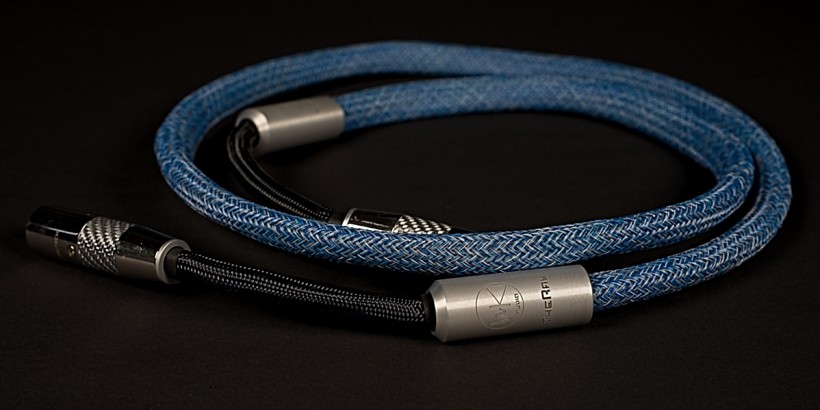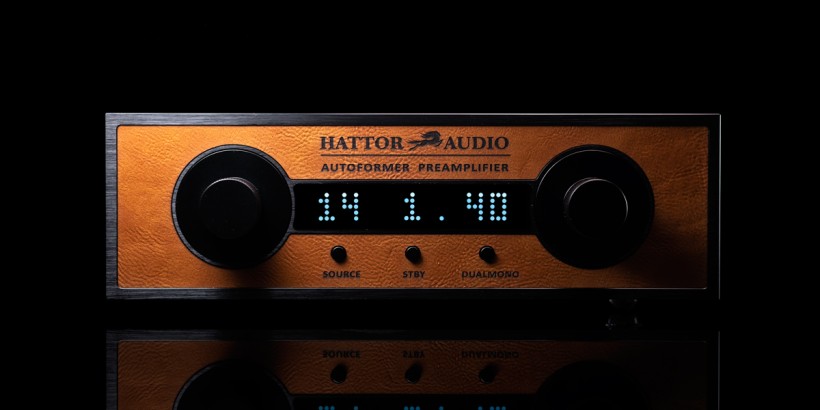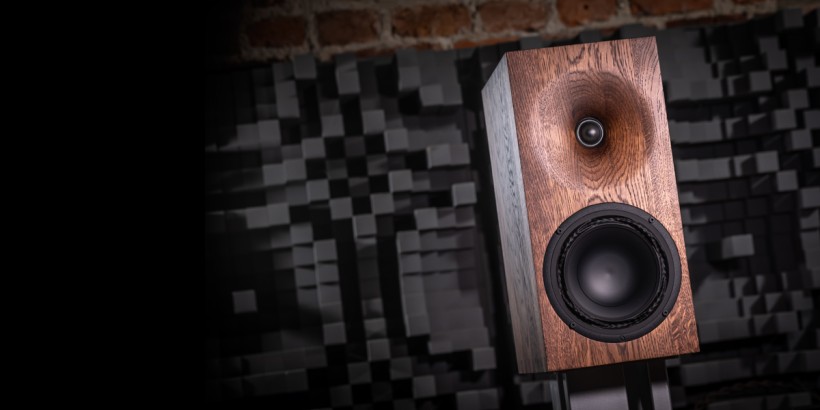Some of you may remember my review of the excellent Pirol semi-active loudspeakers or maybe a coverage of our short trip to Berlin in September last year. In the latter I spoiled a coming introduction of the latest, smallest member of the speaker family, the SoundSpace Systems Robin. The new model is based on the same principle, it was developed by the same man, Michael Plessmann, so my expectations were high. Let’s see if they were matched.
Introduction
I have to assume that not all of you read my review of the Pirol (see HERE), or the above mentioned coverage of the „Mini High End Show in… Berlin” (see HERE), so let me start with a short introduction of the SoundSpace Systems. It’s a young, ambitious, boutique company based in Berlin. The man behind it is Dr. Michael Plessmann. He started his project only in 2017 but being a music passionate lover „for ever” and having his share of DIY experience he was doomed to follow this path sooner or later. What stood out for me in the company’s history was that they took their time and finally presented first two models of high-end semi-active loudspeakers only during the High End Show in Munich in 2019. That’s where we met which led to the review of the, back then, smaller of two models, called Pirol. It was exactly the very same pair which later was presented in a room of Radisson Sobieski Hotel during the Audio Video Show in Warsaw.
If you read any of the above linked texts, you already know, that I was mighty impressed with performance of the Pirol, and even more so, understandably, with the bigger, top of the line, Aidoni. Which, to be honest, came as a bit of a surprise for me as I’d never been much of a fan of semi-active speakers. For one, that’s not the best tool for a reviewer, at least when assessing amplifiers, so sort of out of my interest zone. Two, I’d listened to some designs that really didn’t sound so good with the active bass playing somewhat separately, or aside from the mid and upper frequency sections. What I mean by that is that the sound was not as coherent as I would have liked it to be, or as it has to be to play music in a natural, convincing way. Obviously there were also some that left a good enough impression so that I wouldn’t be biased against such type of design. The SoundSpace Systems speakers, after I had a chance to assess their performance, proved clearly that if properly designed, built and fine-tuned, such a semi-active design may offer numerous advantages over passive one.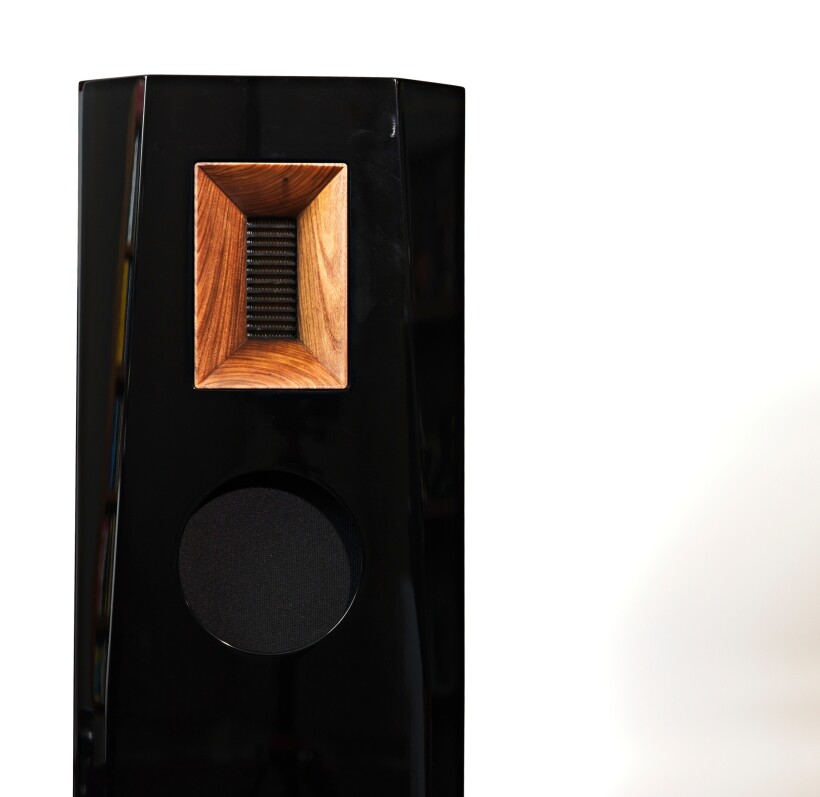
One of them, maybe the key one, being performance in terms of bass. The control that dedicated, build-in amplifiers impose as directly as possible over large bass woofers, is unparalleled and as a result, such loudspeakers are able to deliver music in an absolutely remarkable way that is very hard to achieve in a listening room using passive speakers even driven by some top notch amplifiers. A quick side note – it is also a less expensive (although by no means cheap) way to achieve such a sonic bliss. The scale of presentation, its momentum, a sheer, visceral power delivered by both, Aidoni and Pirol, reminded me of some unforgettable experiences I remembered from live performances. That’s something that passive speakers usually are not able to offer at quite the same level. The biggest Aidoni, I listened to in Michael’s room, proved that beyond any doubt (to me at least). The Pirol did the same in my own room, which is not that big (24 sqm, 3m high). So for most, say, regular users, Pirol seem like a perfect choice. Maybe except for the price tag (that varies significantly depending on configuration and finish) as they do not come cheap.
From our conversations with Michael I learned, that for a while he considered developing a smaller (than Pirol), passive model. Yet his efforts trying to achieve a satisfying level of performance turned out fruitless. Simply, compared to bigger, semi-active siblings, a passive model was not quite able to meet its designer’s expectations. So he changed the approach deciding that even the smallest model would have to feature a build-in amplifier for bass section (and a DSP for the module to work properly with the mid- treble section). In some ways it made it easier for him, as he could use knowledge and experience gained while developing Pirol and Aidoni. Making a product similar, but less expensive and smaller in not as easy task as one may think, so it took a while to develop. And the almost final result of months of hard work we, Janusz and Robert Sikora and I (and you, if you read my coverage) were able to see in September last year at Michael’s place. The speakers were not quite ready yet back then, but the cabinets looked really good, and so did the choice of drivers. It took the designer some more weeks to fine-tune Robins in terms of performance and then he shipped them to me for the world premiere review. I would like to take a moment here and thank the highly professional and helpful crew of the Nautilus Warsaw, who made the delivery to my place much easier in these challenging times.
Robins are significantly smaller (and not as heavy) than Pirols but the general design is quite similar. There is a ribbon tweeter in a small horn and a midrange driver placed on the front baffle. The difference being this time the configuration is a more traditional one with the former sitting above the latter. There is also a second ribbon tweeter on the rear to further improve spatial aspects of the sound reproduction and to add more air to the presentation. There are two, although smaller in diameter (10 vs 12 inch), bass woofers, one on each side and these are driven by a build-in powerful class D amplifier. Just like other SoundSpace Systems speakers, also Robin feature DSP that is responsible for the fantastic coherence which is one of the most prominent features of the whole lineup.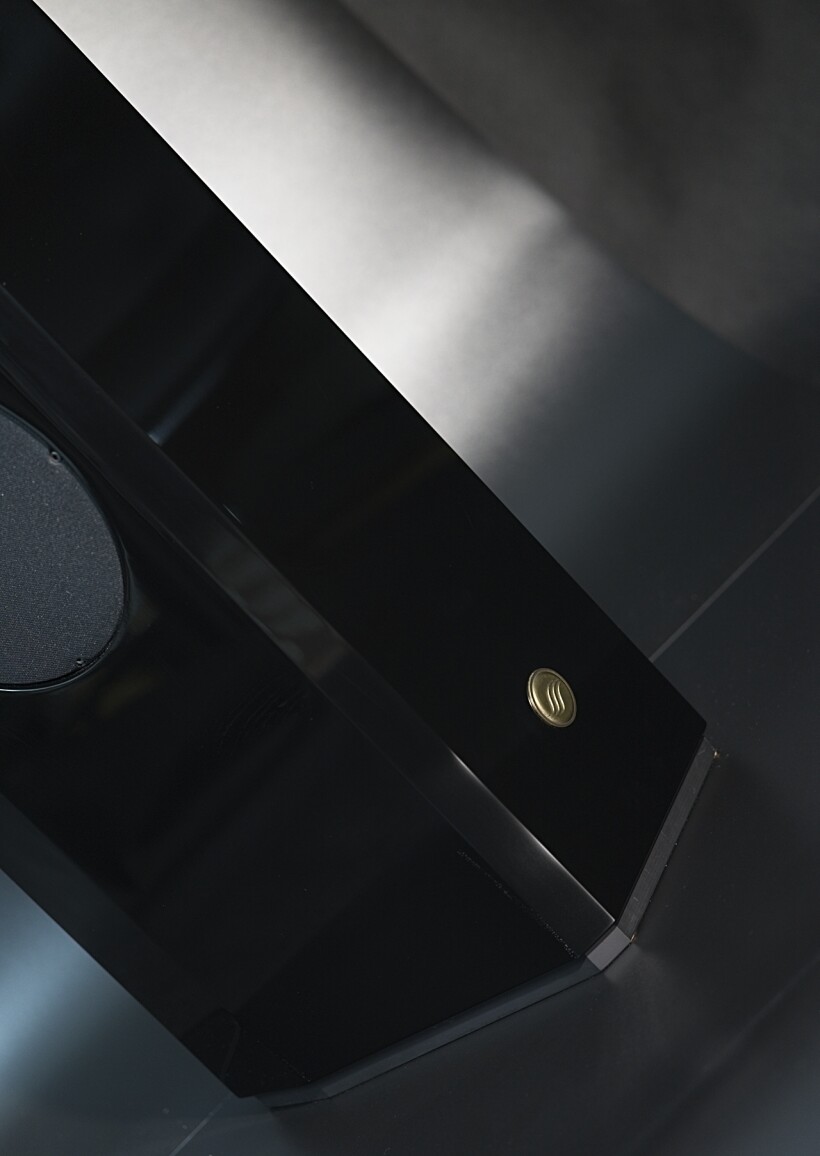
There is one quite significant difference compared to Robin’s bigger siblings – this time all one needs to connect the speakers to the system are speaker cables. Connecting Pirols required a long interconnect and an available pre-out in the preamplifier (or integrated), plus a regular connection using speakers cables. It’s not the case with Robins which will make life easier for many potential users. One still needs two power cables for build-in amplifiers but the only signal carrying connection are speaker cables. This, very first, pair submitted for the review, offered a simple switch that allowed me to use „high” or „low” level of bass. It seems that Michael is considering replacing it with a potentiometer based adjustment offering more than two levels in the near future, but it hasn’t been decided yet. Based on my experience I suggested keeping the present solution. In my room and based on my personal taste and room’s acoustics I used the „low” setting almost all the time and felt no need for the „high” one at all. I assume that in some cases the latter will be preferred but than the former won’t be probably used at all. So does one need more than two settings? I don’t believe so. Ultimately, it is Michael’s job to decide that.
Design & Features
The SoundSpace Systems Robin is a 3-way, semi-active loudspeaker. Being the smallest in the range it still measures 114 (H) by 27 (W) by 43 (D) cm, weighing 42 kg per unit. The pair that arrived for the review featured cabinets made of bamboo (which makes it a more expensive version), although regular version will have one made of MDF. The reviewed pair was finished with a high gloss black lacquer. Same as the previously reviewed Pirols, Robins use ribbon tweeters. This time they are specially developed AMTs supported by rectangular rosewood horns (in a standard version horn is made of MDF). On the rear of each speaker, although hidden under a grill, one finds yet another ribbon tweeter, whose job is to provide additional airiness in the highest frequencies. The manufacturer emphasizes the ability of the Robin’s tweeter to reproduce high levels of SPL at very low distortion and I can confirm from my experience that it is the case, which should make those who like to listen to music at high volume levels very happy.
Below the horn featuring front tweeter sits a 7-inch midrange driver. It is based on the same technology as all midrange drivers used by the SoundSpace Systems’ speakers, consisting of an exponentially shaped diaphragm made of finest cellulose fibers with a silk suspension. The electrical crossovers are reduced to a minimum and do not exceed first order. The midrange is configured as a folded open baffle. Although the size of Robins is significantly smaller than that of Pirols, designer managed to fit in two 10″ carbon drivers per channel. They operate in a closed cabinet with impulse compensation. As Michael explained: „Along with our other loudspeakers, we compensate for efficiency differences to the high and mid-range by means of an active bass with upstream DSP”. The back panel of Robins is quite simple – a pair of high quality speaker terminals, IEC power inlet, on/off switch and a small rotary switch allowing user to adjust bass intensity.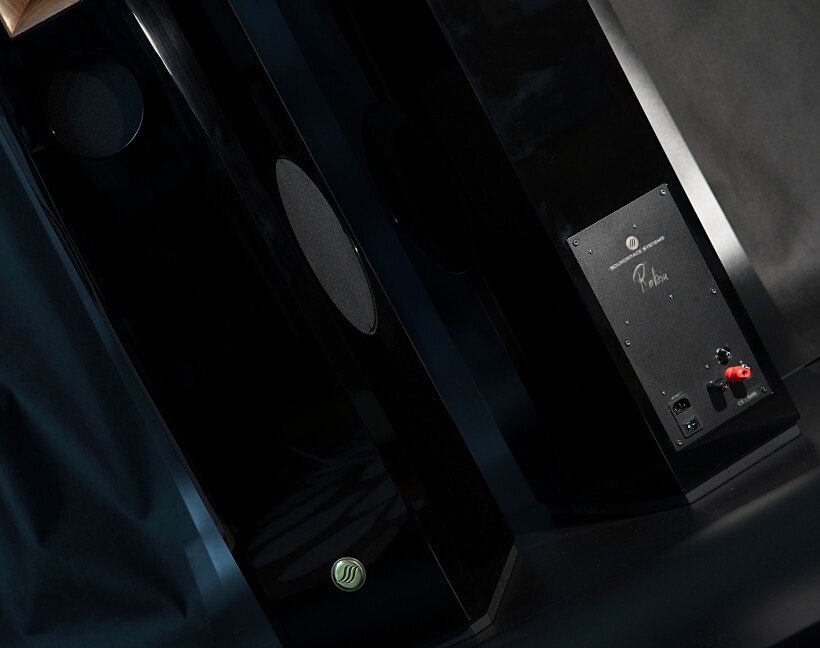
One of the key features of these speakers is their high efficiency of 96 dB combined with a nominal impedance of 8Ω (6.4 Ω minimum) and the bass extension reaching down below 30 Hz. Both, the first two parameters, and active bass section suggest that tubes amplifiers, even low-power SETs, should be good partners for these speakers, which my experience confirmed.
Sound
More than a year separated my extensive listening sessions with Pirols and Robins. That’s a lot of time, especially considering the fact, that between then and now I reviewed as many as 50, maybe even more other audio components including several pairs of speakers. And yet from the get go I felt like getting back together with an old friend. It’s a year later so he’s obviously changed (so am I) to a point, but it’s still the same „old buddy” of mine. Obviously it’s not that Aidoni, Pirol and Robin differ just in size, weight and scale of presentation (which they do), but rather that they share a number of the same sonic features, some general vibe of coherency, musicality and immersiveness that makes them all sound familiar after you get to know at least one of these models. In other words, when listening to them there is no doubt that they share the same DNA which comes from sensitivity and personal view on how good speakers should sound like of their designer. As a result, switching from one SoundSpace Systems model to another does not mean choosing a completely different sound philosophy but rather, when going up the lineup, getting closer to the absolute audio nirvana.
One of the things that should be clear from the start is that none of the three models, not even the mighty Aidoni, are show offs. Do they sound impressive? Hell yeah! But unlike show offs, speakers (and other components) that sweep you off your feet right from the start and consequently wear you down after a few hours or days at most, Robins may surprise or even impress you right from the first track, but they will most likely keep you excited and craving for more for a long, long time. What’s special about Robins (and Pirols and Aidoni) is how skillfully Michael managed to combine a whole set of sonic qualities which translate into a performance that… makes you quickly forget about them, the whole system, room, and the very fact, that what you’re witnessing is just a reproduction of a musical event that took place years ago, possibly half way across the world. All that truly matters is music and emotions it inspires. Music that is present, that is played for you here and now. Many manufacturers describe their audio products as ones that „bring music to life”, or something to that end, but the SoundSpace Systems speakers, including the smallest Robins, actually do just that. And I bet you will realize that quickly, after only a short time spent with them. They are effective this way, but in no way show offs.
Before taking a deeper dive into the capabilities of the SoundSpace Systems Robin speakers let me mention, that I had a chance to listen to them paired with several amplifiers. That’s one of many highly desirable qualities of semi-active speakers (and only of handful of passive ones). I mean, the output of the amp driving them doesn’t really matter, or at least the wattage is of much less importance than with other types of designs. Obviously, these are still quite expensive speakers so one needs to pair them with some great performer but due to the active bass module and the overall high sensitivity of Robins, all they need is a few high quality watts. As you may know, I am a SET aficionado, so I gladly took an advantage of these qualities and used a variety of amplifiers during my test. The bunch included my 300B SET (a modified ArtAudio Symphony II – 2x8W), the Felix Audio Duals (double 2A3 mono-blocks delivering around 7W per channel), but also my trusted Class A GrandiNote Shinai integrated (solid-state, 2x37W), LampizatOr Metamorphosis (hybrid mono-blocks, class AB, 2x300W) and some others.
I believe that’s one of the key pieces of information for all potential users of Robins. Why? Simply because it means that they can focus solely on their sonic (aesthetic/brand/technological or any other) preferences when choosing an amplifier to drive them. Whether they pick up a solid-state, tube, hybrid design, whether the chosen one offers 5 or 500 watts, Robins won’t stand in its way to prove its worth. One needs to make sure it offers a top notch performance and that its sonic character fits one’s personal taste as the speakers are pretty neutral in this regard. It’s quite important as while with each amplifier Robins do display a certain, constant set of qualities, the overall performance does depend largely on quality and character of the signal one feeds them with. I will focus on these most prominent features that new SoundSpace Systems’ speakers offered in every setup I tried them in, but once in a while I will indicate also specific qualities emphasized by particular amplifier.
One of the main reasons, at least that’s what I think, for choosing semi-active speakers over passive ones, is their advantage in terms of bass reproduction (I mean, in terms of quality). So what about Robins? Are they capable of delivering unparalleled bass performance that only a handful other speakers can match? Absolutely. But it’s not about the most visceral reproduction of the lower end, not about sheer power. Whatever the music, whatever the amplifier driving them, there is no doubt, not even for a second, that the bass is there to do its job in a fabulous, convincing way. Yet, it is also immediately clear, that it is there to support the midrange and treble, not to dominate them. Even though I started my assessment of the Robins driving them with my 8W 300B SET, I simply loved the performance of Ron Carter from the „Complete Stockholm Tapes” or Ray Brown’s from „Soular Energy”. Performances, I should add for those not familiar with these albums, for the significant part, focused on the double bass. It turned out that the result of a combination of the amazingly colorful or tuneful, rich, resolving 300B SET and active bass modules was simply spectacular. Texture, timbre, richness, resolution, effortlessness of the presentation delivered by my favorite triodes combined with fantastic control and definition of the lower end provided by Robins resulted in a unique, complete in ever possible way, feeling of a quite live-like presentation.
To be perfectly honest, not quite as live-like as with Pirols, as the latter are capable of delivering even higher level of energy, more of this „being there” feeling. Yet, Robins did a fantastic job of immersing me in the event. The difference being, they brought the event to me, to my room rather than took me there, to the venue. It is about the energy, scale of presentation, about delivering sound in an even more effortless, hence more true, more real way by the bigger siblings. Don’t get me wrong, Robins did a fabulous job filling the room with a powerful, rich, energetic sound, it’s just that Pirols did an even better one (as they should have considering that they cost almost twice as much). While the energy level might have been bit lower making the presentation just slightly less „live-like”, the „little” speakers still did use lot of acoustic cues from live recordings. It’s just that they tended to build the soundstage closer to me, or in other words, partially in front of the speakers. That’s why the presentation as a whole seemed more intimate, closer, thus more here and now and not then and there, if you know what I mean. Is it a bad thing? Not at all. It’s a different way of presenting recorded music, and the difference is most noticeable with live recordings, as with studio ones these elements do not matter that much.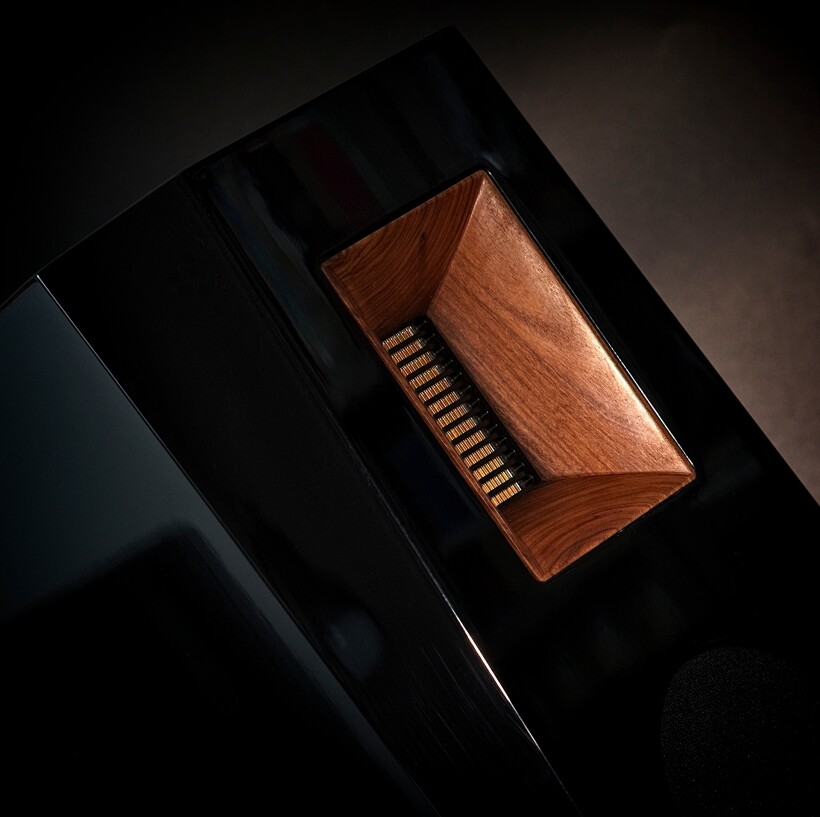
Robins, following in the footsteps of their older/bigger siblings, don’t sound particularly analytic, yet they definitely are quite revealing. During the quite long assessment period I purchased some new vinyl records including highly sought after and almost impossible to get in Europe double 45 r.p.m. Impex release of the famous „Friday night in San Francisco”. Instead of listening to it the day I got it I decided to „save it” for the final listening session with Robins. I know this album by heart as I’ve listened to it dozens, possibly even more than a hundred times from vinyl, CD and hi-res files. Yet, the new release played using Robins (driven by GrandiNote Shinai) proved that there were still elements of the recording I hadn’t realized were there before, or maybe I hadn’t paid attention to them. Part of the credit has to go to this fantastic release, by it was Robins that took upon themselves the job of conveying the newly discovered abundance of information read by my J.Sikora turntable from the grove. Those who know this recording realize, that it is not really about the bass – it’s „just” three acoustic guitars after all – yet there was this new level of live performance energy, even better differentiation between these three brilliant musicians, more lively interaction between them and with the fans. Robins allowed me, a wonna be guitarist, whenever I chose to, to study effortlessly the style and technique of each performer and the sound, timbre and texture of their quite different instruments. Still, the presentation was so natural, so immersive that the deep dive into individual performances was only a choice, an option. It was actually much easier to get carried away with the natural flow of music.
I spent a considerable amount of time with Robins playing classical music – lots of my favorite operas, symphonies by Mozart, Beethoven, Mahler, some chamber music. Again and again the reviewed speakers proved their remarkable ability of going with the flow, so to speak. They seemed highly entertaining playing joyful music by Wolfgang Amadeus, and dead serious digging into Mahler. Powerful, dynamic, yet refined, sophisticated, highly resolving, detailed but focused on the flow of music, on coherency, on performances and dramatic side of the played pieces rather than recording quality (although the latter was nicely differentiated too). Again they proved their ability to resolve even the most complex passages, creating vast, multi-layer soundstages, brilliantly focusing listener’s attention on soloists when needed, or striking with a collective, mighty power of a big orchestra. The dynamics on both, the large, macro scale, as well as on the micro level was breathtaking particularly when I pushed the volume way below levels I am used to. The point was, just as the manufacturer claimed, that these speakers handle high volume levels really well. There was no compression, no distortion of any kind but rather the same clarity, coherence and highly enjoyable way of delivering music as when playing quietly.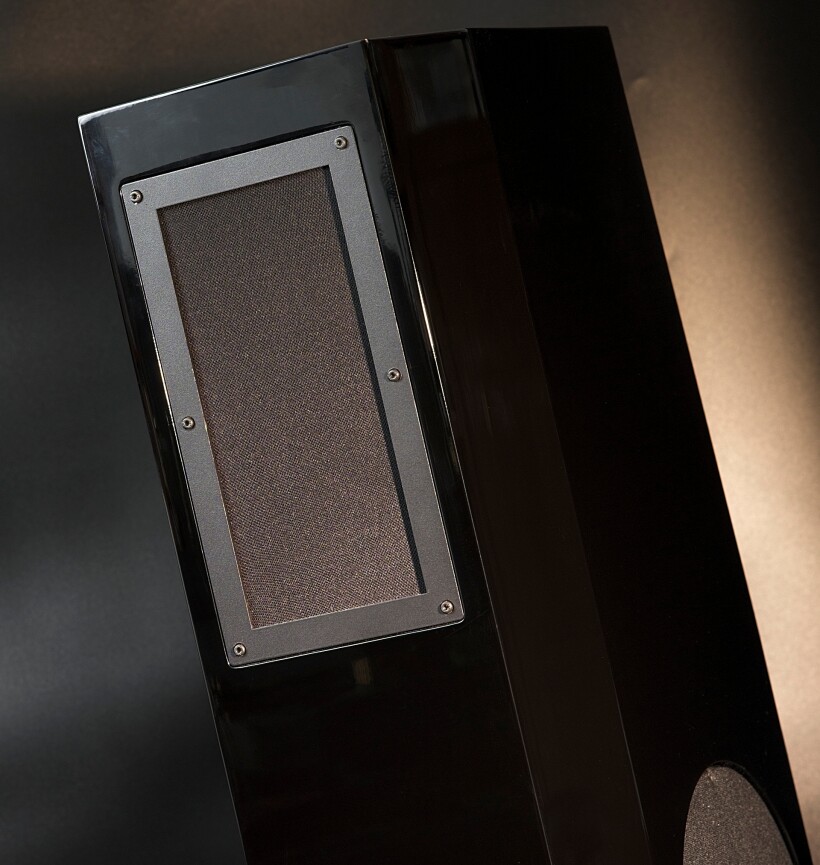
The presentation was open, airy and it seemed like these not that big speakers, were able to play any music with the same ease and precision. While standing by the notion that the Robins benefit from high quality recordings, being fully capable of displaying the wealth of information these offer, I also have to say that when it comes to those of a lesser quality but still interesting because of performance/music itself, they still did an amazing job. Like with the historic recordings of Josef Hofmann, the absolutely brilliant pianist (and inventor) born in Krakow whose takes on Chopin, Brahms and others are simply staggering. The point is most of them were recorded before the Second World War hence the quality is not definitely not an „audiophile” one. Yet, the performance itself, the way he played, how he felt the flow of music, is absolutely remarkable and Robins were able to „ignore”, or rather let me ignore, the technical downsides focusing solely on his brilliant interpretation of music.
Another take on „not that perfectly” recorded music came along with long sessions with rock music. Between Robins, Aerosmith and AC/DC, Led Zeppelin and Pink Floyd, Iron Maiden and Rush, which are not audiophile recordings (although some come close), I had so much fun! Sure, for these albums I definitely preferred Robins driven by solid-states, but remember that Shinai is a class A and Metamorphosis monos are of hybrid design (with tubes in the input), so not the most „raw” transistors on the market. Both of these amps provided not only high dynamics, but also very rich, dense midrange which is a key to conveying a true sound of rock electric guitars and vocals. Combined with this outstanding control of the bass range ensured by active modules, the system delivered a smashing performances. Fantastic pace&rhythm, high energy, incredible drive and a truly important quality – the so-called fun factor – it was all there. As I’ve mentioned before, the energy level was not quite on par with that of Pirols, so the stadium packed with people singing along with Brian Johnson was not that huge, but it was still mighty impressive.
Just to be clear – I listened to rock also with 300B SET or 2A3 amps and it also sounded fantastic. It’s just that the solid-states had a little edge over tube designs when it came to this genre but only to the same extend, that SET had an edge when it came to refined, acoustic setups. Me personally, I would go with a setup with Robins and the best low power tube amp I’d be able to get – Kondo Souga comes to mind. But I guess there are other who will pair them with powerful solid-states. It’s not about being right or wrong, but about finding a setup fulfilling our needs in the best possible way. SoundSpace Systems Robins are so versatile in terms of amplification one can pair them with, that only very few others can compete in this regard. That’s a very unique virtue that is only a cherry on a top of one of the most complete sets of qualities I ever witness having reviewed more than a hundred different loudspeakers over the years.
Summary
There are two main ways one can approach when getting to know a new audio brand. One can start with an entry level product and make one’s way up the lineup or do the opposite. The latter was the case of me getting acquainted with SoundSpace Systems loudspeakers, although not necessarily by my choice. I first heard the Aidoni in Munich, later reviewed the Pirol and now got a chance to assess the latest most affordable add on to this German brand’s offer, the Robin. Starting from the bottom and making way to the top would have, no doubt, impressed me with performance progress with each individual model. Going from the top might have impressed me even more since I had a chance to learn how much of this seemingly unlimited potential of the top model is still there with the most affordable (although again, by no means cheap) one, the Robin.
The semi-active design is just a part of this puzzle. Picking up the right drivers is another. Building the right cabinets, choosing proper cabling, crossover elements and finally developing just the most fitting DSP was another. But ultimately it all came down to spending numerous hours listening to them and fine-tuning them until the sound was simply right. Because that’s what ultimately makes the SoundSpace Systems Robins so unique. Just like their older, bigger siblings, they always focus on music using all these meticulously crafted and selected components perfectly working together to convey the very essence of every recording to a listener. They sound incredibly dynamic but smooth, energetic and immersive, highly detailed but at the same time uniquely coherent. They are able to differentiate recordings really well but won’t make you want to get rid of half of your music collection that is not of the top, audiophile quality. They always find a way to present a good performance and interesting music in an immersive way that makes listener crave for more.
The final piece of this puzzle is the fact, that one can pair the Robin speakers with almost any amplifier, regardless of its output, or technology behind it. All that matter is its performance level, the higher the better, and character, as it will shape the sound Robin reproduce. Go ahead, give them a try – these might be the only speakers you’ll ever need. Unless, of course, having room at least comparable to mine in size, or preferably bigger, you can afford Pirol or even Aidoni (for much bigger room) – then go with one of them to push the limits of live-like performance even further.
Technical specifications (according to the manufacturer):
- System: 3 way
- Power Rating: 10 – 250 W
- Frequency Range: 24 – 35.000 Hz
- Impedance: 8 Ohm nominal, 6.4 Ohm minimum
- Efficiency: 96 dB/W/m
- Maximum SPL: 108 dB
- Dimensions (H x W x D): 114 x 27 x 43 cm
- Weight: 42 kg per speaker
Price (when reviewed):
- SoundSpace Systems Robin (reviewed version with bamboo cabinets and rosewood horn): €34.850 (intro price is € 31,000)
- SoundSpace Systems Robin (standard version with MDF in silk coat cabinets and horns): €28,000
Manufacturer: SOUNDSPACE SYSTEMS
Associated equipment:
- Analogue front end: J.Sikora Standard MAX turntable, J.Sikora KV12 tonearm, AirTight PC-3, phonostages: Grandinote Celio mk IV, ESE Lab Nibiru V 5.
- Digital source: a passive, custom PC with WIN10, Roon, Fidelizer Pro 7.10, JCat USB Femto card with iFi power supply, Hdplex linear power supply for PC, JCAT USB Isolator
- D/A Converter: LampizatOr Pacific +Ideon Audio 3R Master Time (USB signal regenerator)
- Power amplifier: GrandiNote Shinai, LampizatOr Metamorphosis, Art Audio Symphony II (modified)
- Preamplifier: Audia Flight FLS1
- Loudspeakers: GrandiNote MACH4, Ubiq Audio Model ONE Duelund Edition.
- Interconnects: Hijiri Million, Hijiri HCI-20, TelluriumQ Ultra Black, KBL Sound Zodiac XLR, David Laboga Expression Emerald USB, TelluriumQ Silver USB
- Speaker cables: LessLoss Anchorwave
- Power cables: LessLoss DFPC Signature, Gigawatt LC-3
- Power: Gigawatt PF-2 MK2 and Gigawatt PC-3 SE Evo+; a custom power line with Gigawatt LC-Y in-wall cable; Gigawatt G-044 Schuko and Furutech FT-SWS-D (R)
- Racks: Base VI, Rogoz Audio 3RP3/BBS
- Anti-vibration accessories: ROGOZ-AUDIO SMO40 and CPPB16 platforms and ROGOZ AUDIO BW40MKII feet, Franc Accessories Ceramic Disc Slim Feet and Wood Block Platform



























